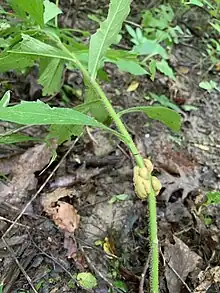Asteromyia tumifica
Asteromyia tumifica is a species of gall midges in the family Cecidomyiidae.[1][2][3][4] This fly causes blister galls on green stems at the base of goldenrod stems. It has a fungal symbiont responseible for forming a black, hard cast around full-grown larvae. The fungi are trasported by the female midges in the ovipositor and spores are trnsferred at the time of egg insertion into the stem. [5]
| Asteromyia tumifica | |
|---|---|
 | |
| A. tumifica stem gall | |
| Scientific classification | |
| Domain: | Eukaryota |
| Kingdom: | Animalia |
| Phylum: | Arthropoda |
| Class: | Insecta |
| Order: | Diptera |
| Family: | Cecidomyiidae |
| Genus: | Asteromyia |
| Species: | A. tumifica |
| Binomial name | |
| Asteromyia tumifica (Beutenmuller, 1907) | |
| Synonyms[1] | |
| |
References
- "Asteromyia tumifica Report". Integrated Taxonomic Information System. Retrieved 2018-05-06.
- "Asteromyia tumifica species details". Catalogue of Life. Retrieved 2018-05-06.
- "Asteromyia tumifica". GBIF. Retrieved 2018-05-06.
- "Asteromyia tumifica Species Information". BugGuide.net. Retrieved 2018-05-06.
- Borkent, Art (1985). "Gall midges (Diptera: Cecidomyiidae) are vectors for their fungal symbionts" (PDF). Symbiosis. 1: 185–194.
Further reading
- Gagné, Raymond J.; Jaschhof, Mathias (2017). A Catalog of the Cecidomyiidae (Diptera) of the World, Fourth Edition (PDF). Agricultural Research Service, US Department of Agriculture.
- Gagné, Raymond J.; Jaschhof, Mathias (2014). A Catalog of the Cecidomyiidae (Diptera) of the World (PDF) (Report). Systematic Entomology Laboratory, USDA.
This article is issued from Wikipedia. The text is licensed under Creative Commons - Attribution - Sharealike. Additional terms may apply for the media files.